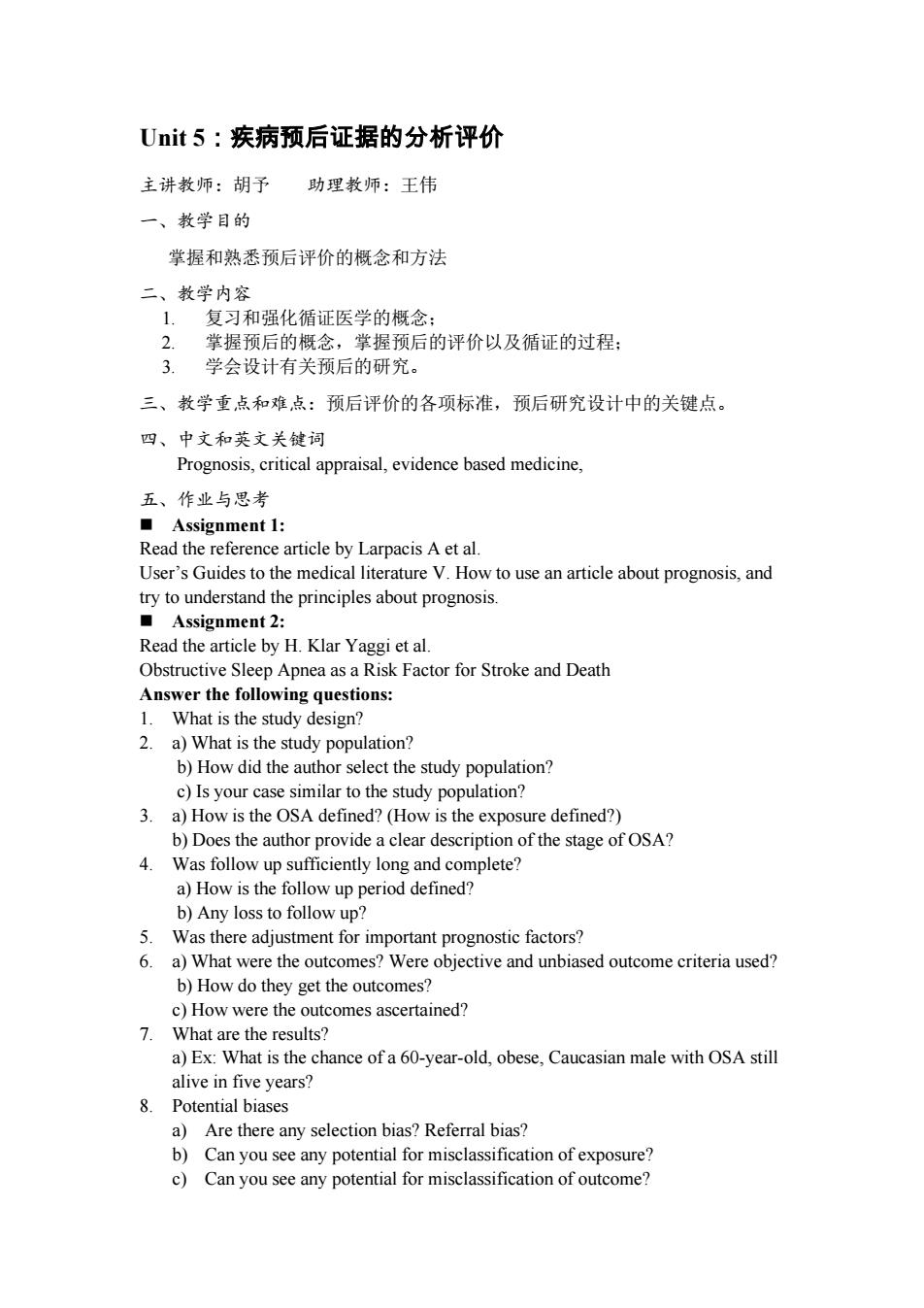
Unit5:疾病预后证据的分析评价 主讲教师:胡予 助理教师:王伟 一、教学目的 掌握和熟悉预后评价的概念和方法 二、教学内容 复习和强化循证医学的概念 掌握预后的概念,掌握预后的评价以及循证的过程: 3 学会设计有关预后的研究。 三、教学重点和难点:预后评价的各项标准,预后研究设计中的关键点。 四、中文和英文关键词 Prognosis,critical appraisal,evidence based medicine, 五、作业与思考 ■Assignment 1: Read the refe erenc article by Larpacis A etal try to understand the principles about prognosis. ■Assignment2: Read the article by H.Klar Yaggi et al. Obstructive Sleep Apnea asa Risk Factor for Stroke and Death ing ques tions: What is the study design? 2.a)What is the study population? b)How did the author select the study population? c)Is your case similar to the study population? 3. a)How is the OSA defined?(How is the exposure defined?) b)Does the author provide a clear description of the stage of OSA? 4. Was follow up sufficiently long and complete? a)How is the follow up period defined? b)Any loss to follow up? rtant pr rognostic factors? umeWere obiective and unbiased oumrfr 6 b)How do they get the outcomes? c)How were the outcomes ascertained? 7. What are the results? a)Ex:What is the chance ofa 60-year-old,obese,Caucasian male with OSA still alive in five years? 8. Potential biases a)Are there any selection bias?Referral bias? b)Can you see any potential for misclassification of exposure? c)Can you see any potential for misclassification of outcome?
Unit 5:疾病预后证据的分析评价 主讲教师:胡予 助理教师:王伟 一、教学目的 掌握和熟悉预后评价的概念和方法 二、教学内容 1. 复习和强化循证医学的概念; 2. 掌握预后的概念,掌握预后的评价以及循证的过程; 3. 学会设计有关预后的研究。 三、教学重点和难点:预后评价的各项标准,预后研究设计中的关键点。 四、中文和英文关键词 Prognosis, critical appraisal, evidence based medicine, 五、作业与思考 Assignment 1: Read the reference article by Larpacis A et al. User’s Guides to the medical literature V. How to use an article about prognosis, and try to understand the principles about prognosis. Assignment 2: Read the article by H. Klar Yaggi et al. Obstructive Sleep Apnea as a Risk Factor for Stroke and Death Answer the following questions: 1. What is the study design? 2. a) What is the study population? b) How did the author select the study population? c) Is your case similar to the study population? 3. a) How is the OSA defined? (How is the exposure defined?) b) Does the author provide a clear description of the stage of OSA? 4. Was follow up sufficiently long and complete? a) How is the follow up period defined? b) Any loss to follow up? 5. Was there adjustment for important prognostic factors? 6. a) What were the outcomes? Were objective and unbiased outcome criteria used? b) How do they get the outcomes? c) How were the outcomes ascertained? 7. What are the results? a) Ex: What is the chance of a 60-year-old, obese, Caucasian male with OSA still alive in five years? 8. Potential biases a) Are there any selection bias? Referral bias? b) Can you see any potential for misclassification of exposure? c) Can you see any potential for misclassification of outcome?
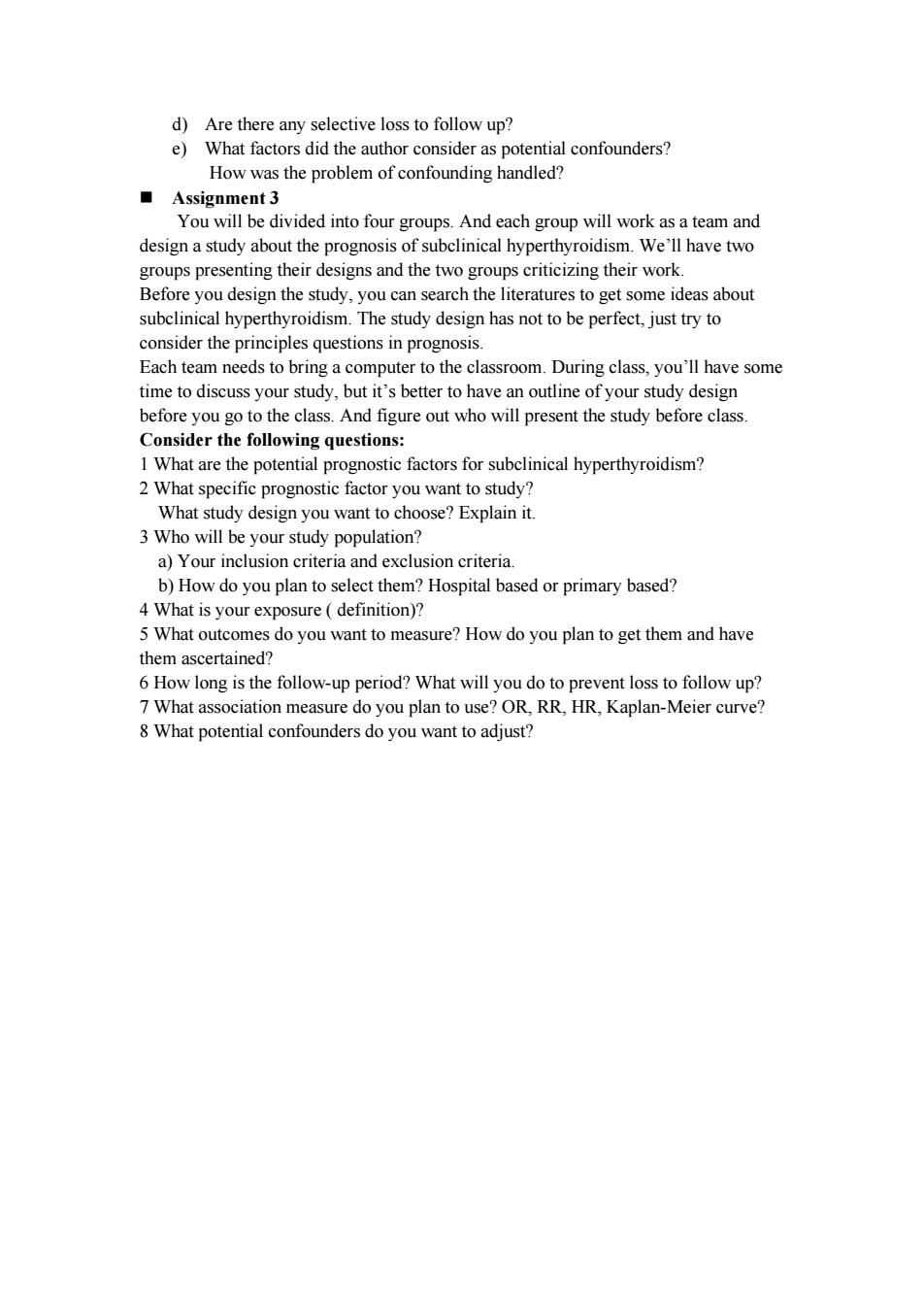
d)Are there any selective loss to follow up? e)What factors did the author consider as potential confounders? How was the problem of confounding handled? Assignment 3 You will be divided into four groups.And each group will work as a team and design a study about the prognosis of subclinical hyperthyroidism.We'll have two groups presenting their designs and the two groups criticizing their work. tures to ge some ideas about consider the principles questions in prognosis. Each team needs to bring a computer to the classroom.During class,you'll have some time to discuss your study,but it's better to have an outline of your study design before you go to the class.And figure out who will present the study before class Consider the following questions What are the potential prognostic factors for subclinical hyperthyroidism? 2 What specific prognostic factor you want to study? What study design you want to choose?Explain it. 3 Who will be your study population? a)Yourinclsioncnteriaamdexclusioncriternia b)How do you plan to select them?Hospital based or primary based? 4 What is your exposure(definition)? 5 What outcomes do you want to measure?How do you plan to get them and have them ascertained? ent loss to follow up 8 What potential confounders do you want to adjust?
d) Are there any selective loss to follow up? e) What factors did the author consider as potential confounders? How was the problem of confounding handled? Assignment 3 You will be divided into four groups. And each group will work as a team and design a study about the prognosis of subclinical hyperthyroidism. We’ll have two groups presenting their designs and the two groups criticizing their work. Before you design the study, you can search the literatures to get some ideas about subclinical hyperthyroidism. The study design has not to be perfect, just try to consider the principles questions in prognosis. Each team needs to bring a computer to the classroom. During class, you’ll have some time to discuss your study, but it’s better to have an outline of your study design before you go to the class. And figure out who will present the study before class. Consider the following questions: 1 What are the potential prognostic factors for subclinical hyperthyroidism? 2 What specific prognostic factor you want to study? What study design you want to choose? Explain it. 3 Who will be your study population? a) Your inclusion criteria and exclusion criteria. b) How do you plan to select them? Hospital based or primary based? 4 What is your exposure ( definition)? 5 What outcomes do you want to measure? How do you plan to get them and have them ascertained? 6 How long is the follow-up period? What will you do to prevent loss to follow up? 7 What association measure do you plan to use? OR, RR, HR, Kaplan-Meier curve? 8 What potential confounders do you want to adjust?
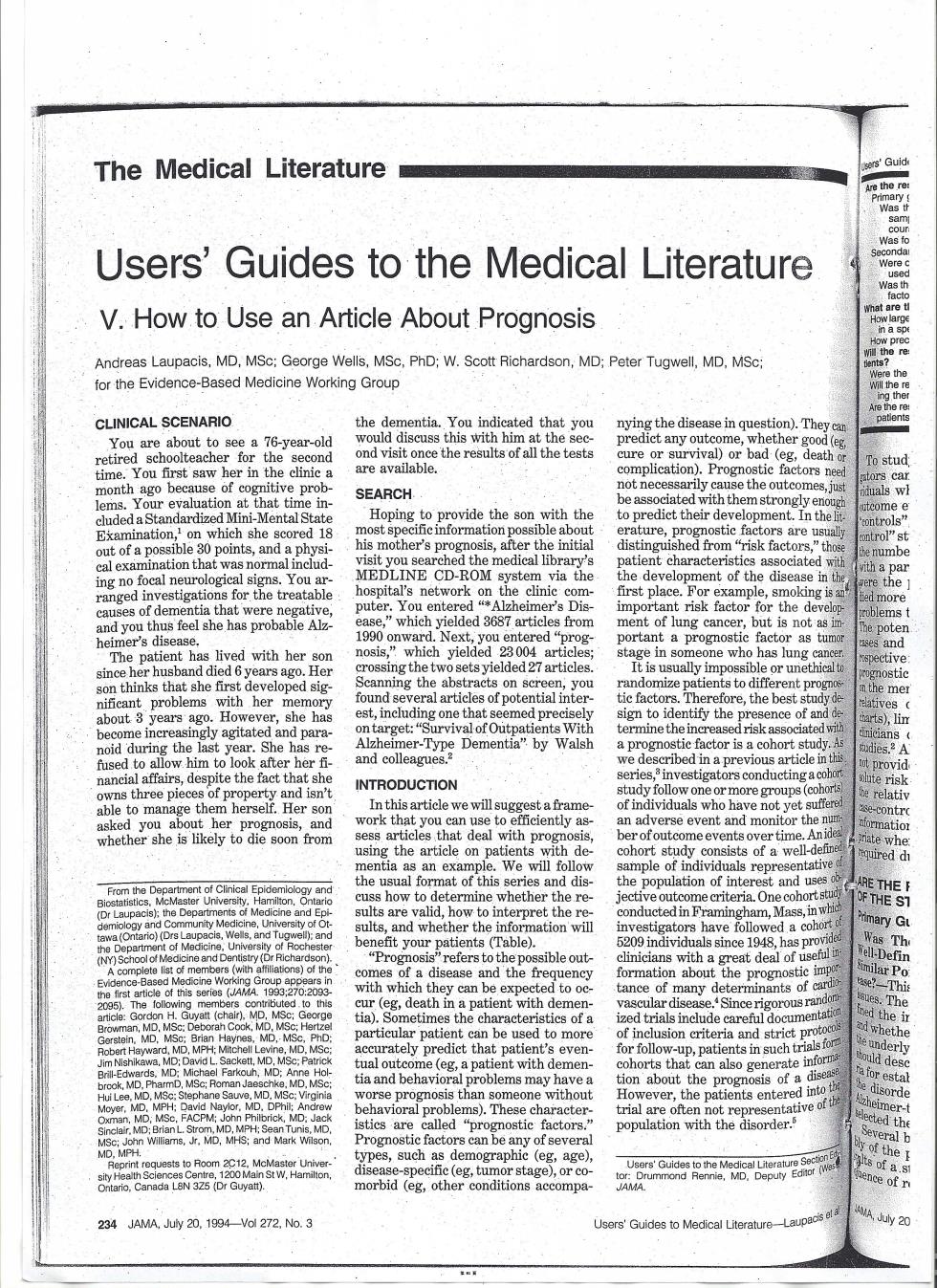
The Medical Literature Users'Guides to the Medical Literature V.How to Use an Article About Prognosis Andreas Laupacis,MD,MSc:George Wells,MSc,PhD:W.Scott Richardson,MD:Peter Tugwell,MD,MSc: for the Evidence-Based Medicine Working Group CLINICAL SCENARIO ed that you se in question).The are available. 0m dcdaSanerahart SEARCH o predict their d d from"risk fact and y 1990 hichielded36sartic es fror t of ung cancer er the bes ents Wit ring they tsg ors cond INTRODUCTION nand mon nd dis the mation will ( of a eg the fret etimes the chara tual out tient that ve s than theenegantd stics are osti factors es,such as 234MAh20.1g94Vd272.N0.3 Usors'Guides to Medical Lteraturo-Lau y20
第 81 页
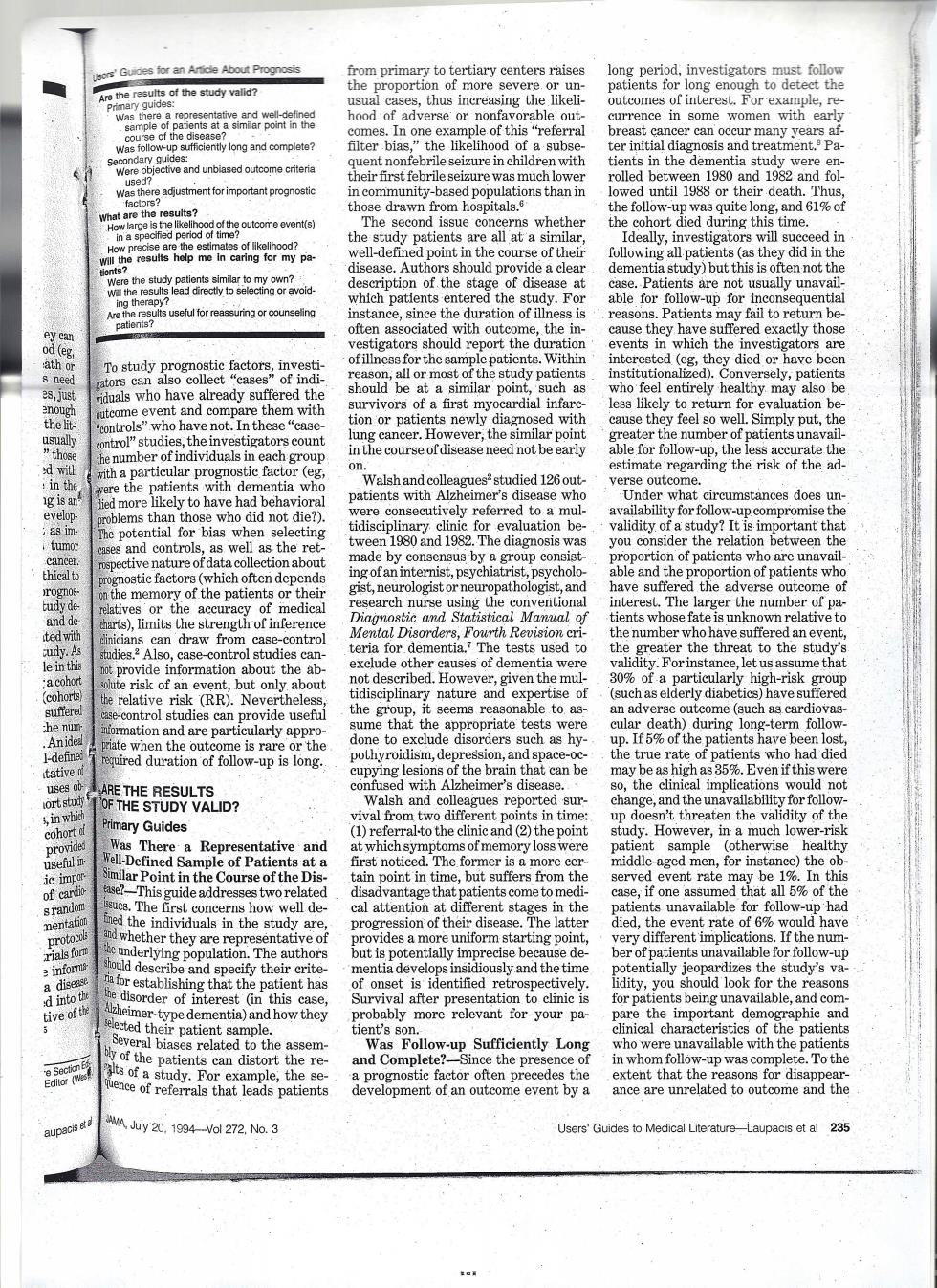
to t cen ng g en or hood of ady ueanst 1%0 this idi过 able fo w-up for he dghe ly suffe or on or y dia use the n thes course of d eve able for f fa th de o did n e 0 1 h of ests ribed.How r.giv the hi zh-risk isk (RR).Ne tha the di riat during ofvoid sm.d E- rue rat tie ie the brain th ayea ues abil int in th int in time rat stcon al atte the thet证 or the rea re relevant your nie an w-upSufficiently an d ne re nd Complet oth nt that th vent by a ce are unr dy20,1994-a272.No.3 UsersGuides etl 235
第 82 页
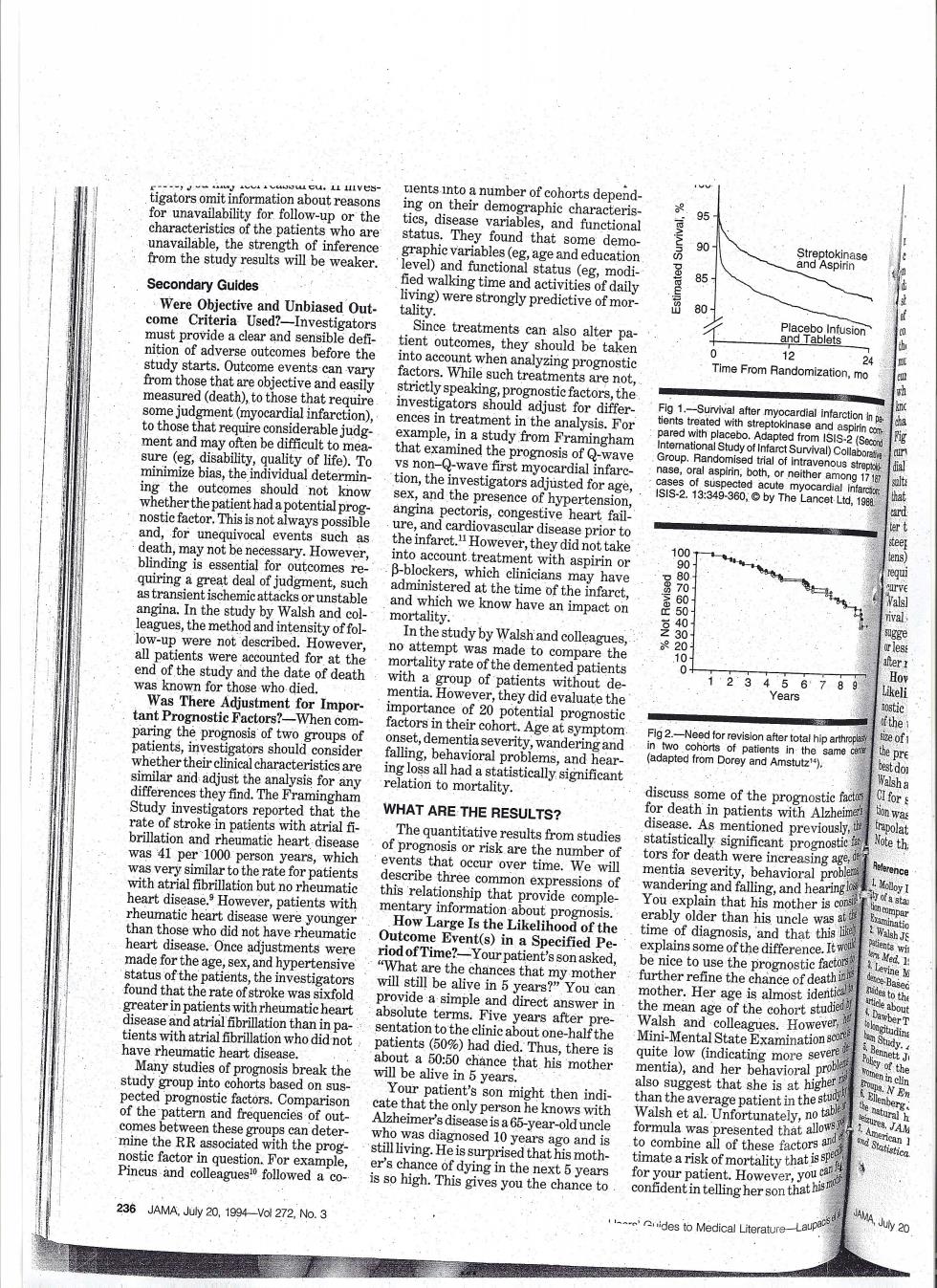
igato somitinformation ow-up o he t the study be wea Secondary Guides treatments me From Bandomlzatio and h)toth 3a ig ev oun de dgment, h an ow ha V W dy by Wala 234v 78 the pror WHAT ARE THE RESUL s)t a er the th he ce that hie k the out. et a mine yea e pro the PcactoTraquestionEore lity that 236 JAMA,14-Vol 22.No.3 2
第 83 页